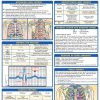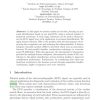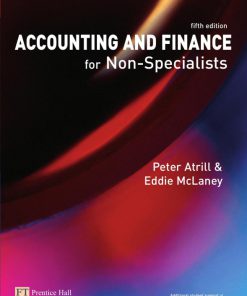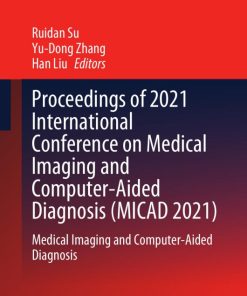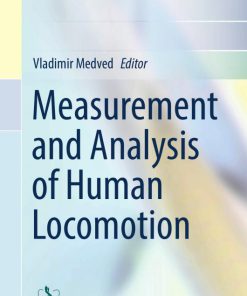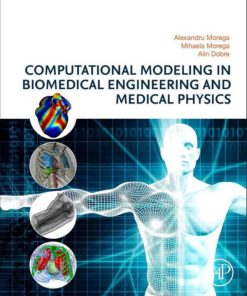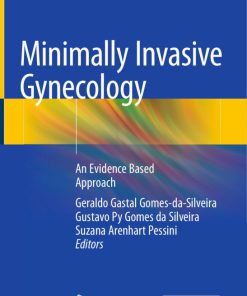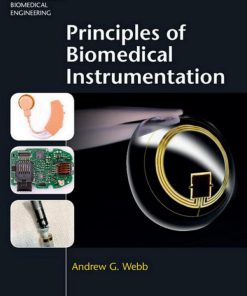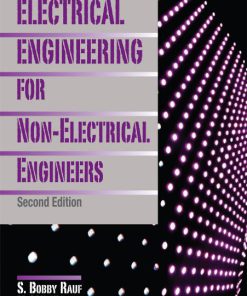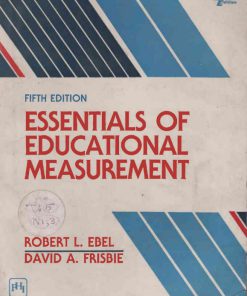(Ebook PDF) Non Invasive Instrumentation and Measurement in Medical Diagnosis 2nd edition by Robert Northrop 1498749933 9781498749930 full chapters
$50.00 Original price was: $50.00.$25.00Current price is: $25.00.
Authors:Robert B. Northrop , Series:Biomedical [44] , Tags:Medical; Biotechnology; Technology & Engineering; Materials Science; General; Biomedical , Author sort:Northrop, Robert B. , Ids:9781498749923 , Languages:Languages:eng , Published:Published:Oct 2017 , Publisher:CRC Press , Comments:Comments:Non-Invasive Instrumentation and Measurement in Medical Diagnosis, Second Edition discusses NIMD as a rapidly growing, interdisciplinary field. The contents within this second edition text is derived from Professor Robert B. Northrop’s experience teaching for over 35 years in the Biomedical Engineering Department at the University of Connecticut. The text focusses on the instruments and procedures which are used for non-invasive medical diagnosis and therapy, highlighting why NIMD is the preferred procedure, whenever possible, to avoid the risks and expenses associated with surgically opening the body surface. This second edition also covers a wide spectrum of NIMD topics including: x-ray bone densitometry by the DEXA method; tissue fluorescence spectroscopy; optical interferometric measurement of nanometer tissue displacements; laser Doppler velocimetry; pulse oximetry; and applications of Raman spectroscopy in detecting cancer, to name a few. This book is intended for use in an introductory classroom course on Non-Invasive Medical Instrumentation and Measurements taken by juniors, seniors, and graduate students in Biomedical Engineering. It will also serve as a reference book for medical students and other health professionals intrigued by the topic. Practicing physicians, nurses, physicists, and biophysicists interested in learning state of the art techniques in this critical field will also find this text valuable. Non-Invasive Instrumentation and Measurement in Medical Diagnosis, Second Edition concludes with an expansive index, bibliography, as well as a comprehensive glossary for future reference and reading.
Non-Invasive Instrumentation and Measurement in Medical Diagnosis 2nd edition by Robert B. Northrop – Ebook PDF Instant Download/DeliveryISBN: 1498749933, 9781498749930
Full download Non-Invasive Instrumentation and Measurement in Medical Diagnosis 2nd edition after payment.
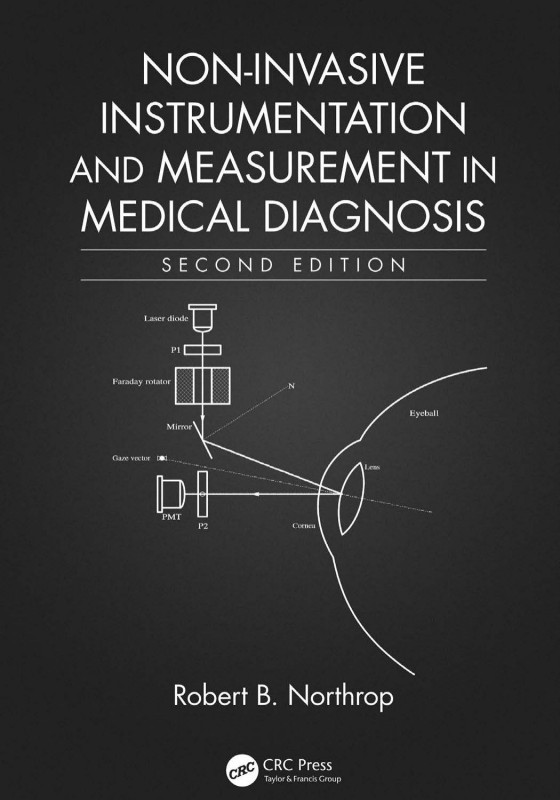
Product details:
ISBN-10 : 1498749933
ISBN-13 : 9781498749930
Author : Robert B. Northrop
Non-Invasive Instrumentation and Measurement in Medical Diagnosis, Second Edition discusses NIMD as a rapidly growing, interdisciplinary field. The contents within this second edition text is derived from Professor Robert B. Northrop’s experience teaching for over 35 years in the Biomedical Engineering Department at the University of Connecticut. The text focusses on the instruments and procedures which are used for non-invasive medical diagnosis and therapy, highlighting why NIMD is the preferred procedure, whenever possible, to avoid the risks and expenses associated with surgically opening the body surface.
Non-Invasive Instrumentation and Measurement in Medical Diagnosis 2nd Table of contents:
1. Introduction to Noninvasive Medical Measurements
1.1 Definitions of Noninvasive, Minimally Invasive, and Invasive Medical Measurements
1.2 Modalities of NI Instrumentation
1.3 Chapter Summary
2. Visual Inspection of Tissues with Certain Endoscopes and Other Optical Devices
2.1 Introduction
2.2 Ophthalmoscopes, Slit Lamps, and Otoscopes
2.2.1 Ophthalmoscopes
2.2.2 Slit Lamps
2.2.3 Otoscopes
2.3 Endoscopes
2.4 CCD and CMOS Active Pixel Image Sensors
2.4.1 CCD Image Sensors
2.4.2 CMOS Active Pixel Image Sensors
2.5 NI Diagnosis of Skin Lesions
2.5.1 Introduction
2.5.2 Malignant Melanoma
2.5.3 Discussion
2.6 Chapter Summary
3. Noninvasive Diagnosis Using Sounds Originating from within the Body
3.1 Introduction
3.1.1 Background
3.1.2 Stethoscopes
3.1.3 Microphones
3.1.4 Acoustic Coupling
3.1.5 Discussion
3.2 Means of Analysis for Acoustic Signals
3.2.1 Introduction
3.2.2 Discrete Fourier Transform and the Power Density Spectrum
3.2.3 Time–Frequency Analysis for Transient Sounds
3.2.4 Discussion
3.3 Heart Sounds
3.3.1 Introduction
3.3.2 Abnormal Heart Sounds
3.3.3 Discussion
3.4 Breath Sounds
3.4.1 Introduction
3.4.2 Abnormal Breath Sounds
3.4.3 Discussion
3.5 Otoacoustic Emissions
3.5.1 Introduction
3.5.2 Otoacoustic Testing
3.5.3 Discussion
3.6 Chapter Summary
4. Measurement of Electrical Potentials and Magnetic Fields from the Body Surface
4.1 Introduction
4.2 Electrodes
4.2.1 Introduction
4.2.2 Electrode Half-Cell Potential
4.2.3 Equivalent Circuits for AgCl Skin Electrodes
4.2.4 Dry Electrodes
4.2.5 Invasive Electrodes
4.3 Biopotential Amplifiers
4.3.1 Introduction
4.3.2 Single-Ended Input Amplifiers
4.3.3 Differential Amplifiers
4.3.4 Op-amps Used for Signal Conditioning
4.3.5 Noise and Low-Noise Amplifiers
4.3.6 Medical Isolation Amplifiers
4.3.7 Driven-Leg ECG Amplifiers
4.3.8 Discussion
4.4 ECG
4.4.1 Introduction
4.4.2 Electrode Placements
4.4.3 Vector Cardiography
4.4.4 ECG Analysis, Feature Extraction, and Diagnosis
4.4.5 Discussion
4.5 EMG
4.5.1 Introduction
4.5.2 Origin of EMGs
4.5.3 EMG Amplifiers
4.5.4 What EMGs Can Tell Us
4.5.5 Discussion
4.6 Electroencephalogram
4.6.1 Introduction
4.6.2 Sources and Classification of the EEG
4.6.3 EEG Recording Systems
4.6.4 2-D Spatial Sampling of Scalp EEG Potentials by Electrode Arrays
4.6.5 EEG Amplifiers, Interfaces, and Signal Processing
4.6.6 Event-Related Potentials and Signal Averaging
4.6.7 Discussion
4.7 Other Body Surface Potentials
4.7.1 Introduction
4.7.2 EOG
4.7.3 Electroretinogram
4.7.4 Electrocochleogram
4.7.5 Discussion
4.8 Magnetoelectric Measurements
4.8.1 Introduction: SQUID and SQUID Arrays
4.8.2 Magnetoencephalogram
4.8.3 Magnetocardiography Using SQUIDs
4.8.4 Other Magnetoelectric Measurements
4.8.5 Optical Atomic Magnetometers
4.8.6 Discussion
4.9 Chapter Summary
5. Noninvasive Measurements of Blood Pressure
5.1 Introduction
5.2 Cuff Sphygmomanometer
5.3 Other Means of Noninvasively Estimating BP
5.4 Chapter Summary
6. Body Temperature Measurements
6.1 Introduction
6.2 Conductive Heat Transfer and Thermometer Response Time
6.3 LIR BB Thermometer
6.3.1 Introduction
6.3.2 Physics of BB Radiation
6.3.3 Temperature Measurement with PYMs
6.3.4 ThermoScan LIR Thermometers
6.3.5 Discussion
6.4 Chapter Summary
7. Noninvasive Blood Gas Sensing with Electrodes
7.1 Introduction
7.2 Transcutaneous O2 Sensing
7.2.1 Introduction: The Clark Electrode
7.2.2 Transcutaneous [O2] (tcpO2) Sensor
7.3 Transcutaneous CO2 Sensing
7.3.1 Introduction: The Stow–Severinghaus Electrode
7.3.2 Transcutaneous tcpCO2 Sensing
7.4 Chapter Summary
8. Tests on Naturally Voided Body Fluids
8.1 Introduction
8.2 Instrumental Methods
8.2.1 Introduction
8.2.2 Dispersive Spectrophotometry
8.2.3 Nondispersive Spectroscopy
8.2.4 Chemical Analysis by SPR
8.2.5 Ion-Selective Electrodes
8.2.6 Flame Photometry
8.2.7 Gas Chromatography
8.2.8 Mass Spectrometry
8.3 What Can Be Learned from Urine?
8.3.1 Introduction
8.3.2 Diagnosis of Early-Stage Pancreatic Cancer from Proteins in the Urine
8.4 What Can Be Learned from Feces?
8.5 What Can Be Learned from Saliva?
8.6 What Can Be Learned from Breath?
8.7 Chapter Summary
9. Plethysmography
9.1 Introduction
9.2 Volume Displacement Plethysmography
9.3 Impedance Plethysmography
9.3.1 Introduction
9.3.2 Self-Balancing, Impedance Plethysmographs
9.3.3 Applications of Impedance Plethysmography
9.3.4 Discussion
9.4 Photo-Plethysmography
9.5 Chapter Summary
10. Pulmonary Function Tests
10.1 Introduction
10.2 Spirometers and Related Equipment
10.3 Tests with Spirometers
10.4 Diffusing Capacity of the Lungs for Carbon Monoxide
10.5 Chapter Summary
11. Measurement of Basal Metabolism
11.1 Introduction
11.2 BMR Test Procedure
11.3 Chapter Summary
12. Ocular Tonometry
12.1 Introduction
12.2 Noncontact, Air-Puff Applanation Tonometer
12.3 Contact Tonometers
12.4 Chapter Summary
13. Noninvasive Tests Involving the Input of Audible Sound Energy
13.1 Introduction
13.2 Acoustic Impedance Measurement of the Respiratory System
13.3 Acoustic Impedance Measurement of the Eardrum (Tympanometry)
13.4 Transthoracic Acoustic Transfer Function as a Possible Measure of Lung Condition
13.4.1 Introduction
13.4.2 Transthoracic Propagation of Broadband Acoustic Noise to Evaluate Pulmonary Health
13.4.3 Use of White Noise Sound Introduced into the Oral Airway to Assess Lung Condition
13.4.4 Discussion
13.5 Chapter Summary
14. Noninvasive Tests Using Ultrasound (Excluding Imaging)
14.1 Introduction
14.2 Doppler Effect
14.3 Doppler Ultrasound for Blood and Tissue Velocity Measurements
14.3.1 Angle-Dependent, CW, Blood Velocity Magnitude Measurement
14.3.2 Directional, CW Doppler System
14.3.3 Angle-Independent, CW Doppler Velocimetry
14.3.4 Pulsed Doppler Systems
14.3.5 Discussion
14.4 NOTOPM System
14.4.1 Introduction
14.4.2 Closed-Loop, Constant-Phase, No-Touch Means of Measurement of OP
14.4.3 Discussion
14.5 Closed-Loop, Type 1, Constant-Phase Difference Ranging System
14.5.1 Introduction
14.5.2 Analysis of a Linear NOTOPM System Using a VPC
14.5.3 Other Applications of the CPDRS Architecture Using Ultrasound
14.5.4 Discussion
14.6 Measurement of Tissue Glucose Concentration By Closed-Loop, Constant-Phase, CW Ultrasound: A Prototype System
14.6.1 Introduction
14.6.2 Approximate Model of How c Varies with Density, ρ
14.6.3 Phase Lag between the Transmitted and Received CW Ultrasound Waves
14.6.4 System Block Diagram for the Constant-Phase Glucose Sensor System
14.6.5 Discussion
14.7 Chapter Summary
15. Noninvasive Applications of Photon Radiation (Excluding Imaging)
15.1 Introduction
15.2 Bone Densitometry
15.2.1 Introduction
15.2.2 DXA Method
15.2.3 Discussion
15.3 NI Diagnosis By Tissue Fluorescence
15.3.1 Introduction
15.3.2 Properties of Fluorescent Molecules
15.3.3 Fluorescence in NI Cancer Diagnosis
15.3.4 Discussion
15.4 Optical Interferometric Measurement of Nanometer Displacements of Biological Surfaces
15.4.1 Introduction
15.4.2 Measurement of Tympanal Membrane Displacement By Fizeau Interferometer
15.4.3 Measurement of Skin Vibration By Optical Interferometry
15.4.4 Discussion
15.5 Laser Doppler Velocimetry
15.5.1 Principles of LDV
15.5.2 LDV Applied to Retinal Blood Vessels
15.5.3 LDV Applied to Skin and Other Tissues
15.5.4 Discussion
15.6 TIR Spectroscopy
15.6.1 Introduction
15.6.2 Direct Measurement of Blood Glucose with IR Spectrosopy
15.6.3 Transcutaneous Measurement of Glucose with IR
15.6.4 Discussion
15.7 Estimation of Blood Glucose from NI Measurement of Optical Rotation of the Aqueous Humor of the Eye (a Prototype System)
15.7.1 Introduction
15.7.2 Open-Loop Gilham Microdegree Polarimeter
15.7.3 Dynamics and Sensitivity of the Closed-Loop Polarimeter
15.7.4 Application of the Modified Gilham Polarimeter to the Measurement of the Optical Rotation of Aqueous Humor in a Model System
15.7.5 Discussion
15.8 Semi-Invasive, Continuous Measurement of Blood Glucose Using Subcutaneous Sensors
15.8.1 Introduction
15.8.2 Biorasis Inc. Glucowizzard Subcutaneous Continuous Glucose Monitoring
15.9 Pulse Oximetry
15.9.1 Introduction
15.9.2 Pulse Oximetry Systems
15.9.3 Discussion
15.10 NI Measurement of Certain Biomolecules By Raman Spectroscopy
15.10.1 Introduction
15.10.2 Diagnostic Applications of Raman Spectroscopy
15.10.3 Discussion
15.11 Chapter Summary
16. A Survey of Medical Imaging Systems
16.1 Introduction
16.2 X-rays
16.2.1 Introduction
16.2.2 Sources of Medical X-rays
16.2.3 X-ray Detectors and Recording Media
16.2.4 X-ray Mammography
16.2.5 Mammography with Ultrasound
16.3 Tomography
16.3.1 Introduction
16.3.2 Formation of Tomograms with the Algebraic Reconstruction Technique
16.3.3 Use of the RT in Tomography
16.4 Positron Emission Tomography
16.4.1 Introduction
16.4.2 PET Process
16.4.3 Some PET Applications
16.5 Magnetic Resonance Imaging
16.5.1 Introduction
16.5.2 MRI Physics
16.5.3 How MRI Works
16.5.4 MRI Contrast Agents
16.6 Single-Photon Emission Tomography
16.6.1 Introduction
16.6.2 Radiochemicals Used in SPECT
16.6.3 Scintillation Crystals Used in Nuclear Medicine
16.6.4 Gamma Cameras and Collimators
16.6.5 Future Trends in Nuclear Medical Imaging
16.7 Optical Coherence Tomography
16.7.1 Introduction
16.7.2 How OCT Works
16.7.3 Applications of OCT
16.8 Ultrasound Imaging
16.8.1 Introduction
16.8.2 Physics of Ultrasound Propagation in Solids and Liquids
16.8.3 Ultrasound Transducers
16.8.4 Doppler Ultrasound Imaging
16.9 Other Imaging Modalities
16.9.1 Introduction
16.9.2 LIR Thermal Imaging of Body Surfaces
16.9.3 Microwave Imaging
16.9.4 EIT in 2-D Imaging
16.10 Chapter Summary
17. Innovations in Noninvasive Instrumentation and Measurements
17.1 Introduction
17.2 DNA Analysis by Polymerase Chain Reaction
17.3 DNA Sequencing with Nanopores
17.4 Fluorescence Tests for Biomolecules: FISH and SKY
17.5 SpectraCube System
17.6 Analytical Microarrays
17.6.1 Introduction
17.6.2 Ab Microarrays
17.6.3 Nucleic Acid Microarrays
17.6.4 Peptide and Protein Microarrays
17.6.5 Glycan Microarrays
17.6.6 Lectin Microarrays
17.7 NI Chemical Tests for Cancer Not Involving DNA
17.7.1 Introduction
17.7.2 Melatonin and Cancer
17.7.3 Pteridines and Cancer: Other Chemical Tests
17.7.4 GM Bacteria for NI tumor Detection
17.7.5 In Vitro Magnetic Levitation of Single Cells for Cancer Detection
17.7.6 Use of Circularly Polarized Light for NI Cancer Detection
17.8 Minimally Invasive Sensors Using Drops of Blood
17.8.1 Introduction
17.8.2 Malaria Parasite Detection Using Magnetic Resonance Relaxometry of Hemozoin in Blood
17.8.3 Colorimetric and Redox Blood Glucose Sensors
17.8.4 Blood Clotting Time (INR) Measurement
17.8.5 Scanning Confocal Microscopy
17.8.6 Liquid Biopsies and the Detection of Cancer
17.9 Blood Alcohol Concentration Estimation by Breathalyzer
17.9.1 BAC Estimation by Measuring Transdermal Alcohol Concentration Using Wearable Sensors
17.9.1.1 Introduction
17.9.1.2 BACtrack Skyn
17.10 Capsule Endoscopy
17.11 Use of Diffuse Reflectance Imaging to Detect Oral Cancer
17.11.1 Introduction
17.11.2 DRI System Design and Applications
17.12 Coregistered Photoacoustic and Ultrasound Imaging
17.13 Chapter Summary
18. Introduction to Noninvasive Therapies
18.1 Introduction
18.2 Brain Stimulation Therapies
18.2.1 Introduction
18.2.2 Repetitive Transcranial Magnetic Stimulation
18.2.3 Transcranial DC Stimulation
18.2.4 Electroconvulsive Therapy
18.2.5 Summary
18.3 Treatment of Osteoarthritis with US
18.3.1 Introduction
18.3.2 US Treatment of OA
18.4 Radiation Therapy versus Cancers
18.4.1 Introduction
18.4.2 Radiation Therapy
18.5 TTF: LF AC Electromagnetic Field Stimulation to Fight Glioblastomas
18.6 Transcutaneous Electrical Nerve Stimulation
18.7 Heat Therapy
18.8 Interferential Current Therapy
18.8.1 Introduction
18.8.2 Applications of ICT
18.8.3 Other forms of ICT
18.8.4 Electrode Placement for ICT
18.9 Electrical and Magnetic Stimulation in Bone Healing
18.9.1 Introduction
18.9.2 Electrical Stimulation Modalities for Bone Healing
18.9.3 Pulsed Magnetic Stimulation for Bone Healing and Other Medical Conditions
18.10 NI Respiratory (Pneumatic) Therapies
18.10.1 Introduction
18.10.2 CPAP and BPAP
18.11 US May Help Treat ad
18.12 Hearing Aids
18.12.1 Introduction
18.12.2 Human Hearing Characteristics
18.12.3 HAs, Frequency Compensation, and Frequency FLowering Technologies
18.12.4 Conclusions
18.13 “Smart” Wound Dressings
18.14 Negative-Pressure Wound Therapy
18.15 Gene Editing with CRISPR-Cas9 and CRISPR-Cpf1 as a Prospective Therapy for Genetic Diseases
18.15.1 Genetic Disorders
18.15.2 Correcting Chromosome Damage with Genetically Engineered CRISPR-Cas9 and CRISPR-Cpf1 Gene Editing Tools
18.16 Chapter Summary
People also search for Non-Invasive Instrumentation and Measurement in Medical Diagnosis 2nd:
non contact measuring instruments
what is measurement in instrumentation
non-invasive measurement
non-invasive or noninvasive
non-invasive instrument


